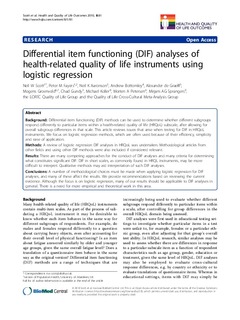Differential item functioning (DIF) analyses of health-related quality of life instruments using logistic regression
Scott, Neil W; Fayers, Peter; Aaronson, Neil K; Bottomley, Andrew; de Graeff, Alexander; Groenvold, Mogens; Gundy, Chad; Koller, Michael; Petersen, Morten A; Sprangers, Mirjam AG
Journal article, Peer reviewed
Permanent lenke
http://hdl.handle.net/11250/2356324Utgivelsesdato
2010Metadata
Vis full innførselSamlinger
Sammendrag
Background: Differential item functioning (DIF) methods can be used to determine whether different subgroups
respond differently to particular items within a health-related quality of life (HRQoL) subscale, after allowing for
overall subgroup differences in that scale. This article reviews issues that arise when testing for DIF in HRQoL
instruments. We focus on logistic regression methods, which are often used because of their efficiency, simplicity
and ease of application.
Methods: A review of logistic regression DIF analyses in HRQoL was undertaken. Methodological articles from
other fields and using other DIF methods were also included if considered relevant.
Results: There are many competing approaches for the conduct of DIF analyses and many criteria for determining
what constitutes significant DIF. DIF in short scales, as commonly found in HRQL instruments, may be more
difficult to interpret. Qualitative methods may aid interpretation of such DIF analyses.
Conclusions: A number of methodological choices must be made when applying logistic regression for DIF
analyses, and many of these affect the results. We provide recommendations based on reviewing the current
evidence. Although the focus is on logistic regression, many of our results should be applicable to DIF analyses in
general. There is a need for more empirical and theoretical work in this area.
